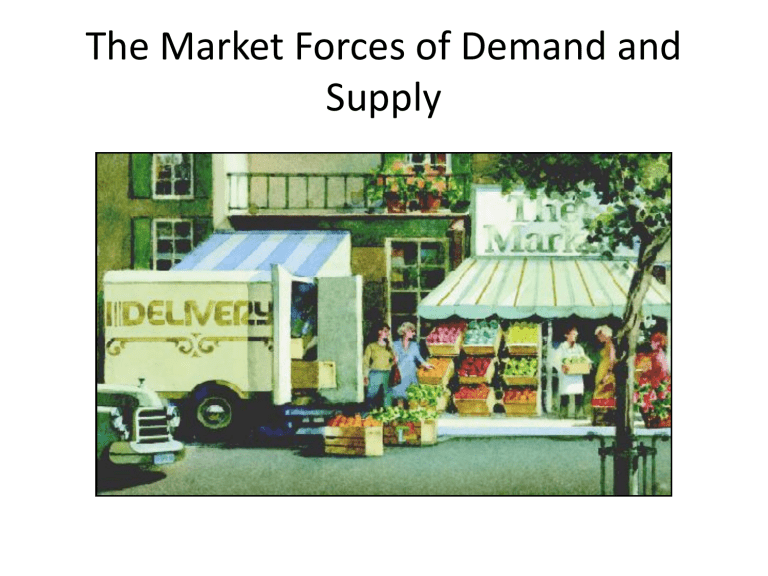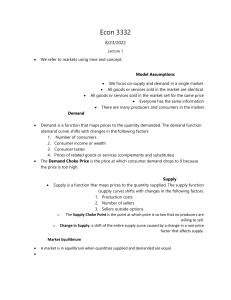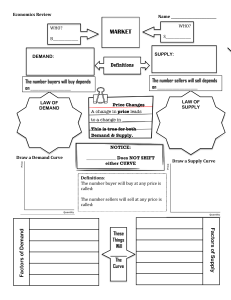
The Market Forces of Demand and Supply • Supply and demand are the two words that economists use most often. • Supply and demand are the forces that make market economies work. • Modern microeconomics is about supply, demand, and market equilibrium. Markets and competition • A market is a group of buyers and sellers of a particular good or service. • The terms supply and demand refer to the behavior of people . . . as they interact with one another in markets. • Buyers determine demand. • Sellers determine supply Competitive • A competitive market is a market in which there are many buyers and sellers so that each has a negligible impact on the market price. DEMAND • Quantity demanded is the amount of a good that buyers are willing and able to purchase. Factors Affecting Demand 1. 2. 3. 4. 5. Price of the Good or Service Consumer’s income Prices of related goods Tastes and Preferences Expectations regarding future prices and incomes 6. Number of buyers 7. Special Influences – wars, calamities, taxes, subsidies,etc. Demand Curve: the relationship between price and quantity demanded • Demand schedule – The demand schedule is a table that shows the relationship between the price of the good and the quantity demanded. • Demand Curve – The demand curve is a graph of the relationship between the price of a good and the quantity demanded Catherine’s Demand Schedule Figure 1: Catherine’s Demand Schedule and Demand Curve for Ice cream Demand • Demand curves are negatively slope or downward sloping The Law of Demand – The law of demand states that, other things equal, the quantity demanded of a good falls when the price of the good rises. Reasons Behind the Downward Sloping Demand Curve • Income Effect – the change in the quantity demanded of a good due to a change in the purchasing power or real income of the consumer as the price of the good changes. • Substitution Effect – the change in quantity demanded of a good as the consumer switch to a relatively cheaper commodity as price changes. Market Demand Versus Individual Demand • Market demand refers to the sum of all individual demands for a particular good or service. • Graphically, individual demand curves are summed horizontally to obtain the market demand curve Figure 2: Changes in Quantity Demanded Price of IceCream Cones A tax that raises the price of ice-cream cones results in a movement along the demand curve. B $2.00 A 1.00 D 0 4 8 Quantity of Ice-Cream Cones • Change in Quantity Demanded – Movement along the demand curve. – Caused by a change in the price of the product Factors Affecting Demand 1. 2. 3. 4. 5. Price of the Good or Service Consumer’s income Prices of related goods Tastes and Preferences Expectations regarding future prices and incomes 6. Number of buyers 7. Special Influences – wars, calamities, taxes, subsidies,etc. Shifts in the Demand Curve • Change in Demand – A shift in the demand curve, either to the left or right. – Caused by any change that alters the quantity demanded except the price. Shifts in the Demand Curve Shifts in the Demand Curve • Consumer Income – As income increases the demand for a normal good will increase. – As income increases the demand for an inferior good will decrease Consumer Income Normal Good Consumer Income Inferior good Shifts in the Demand Curve • Prices of Related Goods – When a fall in the price of one good reduces the demand for another good, the two goods are called substitutes. – When a fall in the price of one good increases the demand for another good, the two goods are called complements Variables Affecting Demand SUPPLY • Quantity supplied is the amount of a good that sellers are willing and able to sell. Factors Affecting Supply 1. 2. 3. 4. 5. 6. Price of the Good or Service Costs of Production Technology Prices of Related Inputs Number of Sellers Expectations regarding Future Prices and Incomes 7. Special Influences- seasons, taxes, import quotas, tariffs, etc. The Supply Curve: the relationship between the price and quantity supplied • Supply Schedule – The supply schedule is a table that shows the relationship between the price of the good and the quantity supplied. Ben’s Supply Schedule Quantity of Cones Supplied Ben’s Supply schedule and Supply curve for Ice cream Supply Quantity of Cones Supplied • Supply Curve – The supply curve is the graph of the relationship between the price of a good and the quantity supplied. The Law of Supply – The law of supply states that, other things equal, the quantity supplied of a good rises when the price of the good rises. Change in Quantity Supplied Price of IceCream Cone S C $3.00 A rise in the price of ice cream cones results in a movement along the supply curve. A 1.00 0 1 5 Quantity of Ice-Cream Cones Change in Quantity Supplied – Movement along the supply curve. – Caused by a change in anything that alters the quantity supplied at each price. Market supply versus Individual Supply • Market supply refers to the sum of all individual supplies for all sellers of a particular good or service. • Graphically, individual supply curves are summed horizontally to obtain the market supply curve. Factors Affecting Supply 1. 2. 3. 4. 5. 6. Price of the Good or Service Costs of Production Technology Prices of Related Inputs Number of Sellers Expectations regarding Future Prices and Incomes 7. Special Influences- seasons, taxes, import quotas, tariffs, etc. Shifts in the Supply Curve • Change in Supply – A shift in the supply curve, either to the left or right. – Caused by a change in a determinant other than price. • • • • Input prices Technology Expectations Number of sellers Shifts in the Supply Curve Variables Affecting Supply SUPPLY AND DEMAND TOGETHER • Equilibrium refers to a situation in which the price has reached the level where quantity supplied equals quantity demanded. • Equilibrium Price – The price that balances quantity supplied and quantity demanded. – On a graph, it is the price at which the supply and demand curves intersect. • Equilibrium Quantity – The quantity supplied and the quantity demanded at the equilibrium price. – On a graph it is the quantity at which the supply and demand curves intersect. SUPPLY AND DEMAND TOGETHER Market equilibrium Markets not in equilibrium Markets not in equilibrium • Surplus – When price > equilibrium price, then quantity supplied > quantity demanded. • There is excess supply or a surplus. • Suppliers will lower the price to increase sales, thereby moving toward equilibrium. • Shortage – When price < equilibrium price, then quantity demanded > the quantity supplied. • There is excess demand or a shortage. • Suppliers will raise the price due to too many buyers chasing too few goods, thereby moving toward equilibrium. • Law of supply and demand – The claim that the price of any good adjusts to bring the quantity supplied and the quantity demanded for that good into balance. Shifts in Curves versus Movements along Curves – A shift in the supply curve is called a change in supply. – A movement along a fixed supply curve is called a change in quantity supplied. – A shift in the demand curve is called a change in demand. – A movement along a fixed demand curve is called a change in quantity demanded. 3 steps to Analyzing Changes in Market Equilibrium 1. Decide whether the event shifts the demand curve, supply curve or both. 2. Decide in which direction the curve shifts. 3. Use the supply and demand diagram to see how the shift changes the equilibrium price and quantity. The Effect of a Decrease in Supply The effect on price and quantity as Demand or Supply Shifts Summary • Economists use the model of supply and demand to analyze competitive markets. • In a competitive market, there are many buyers and sellers, each of whom has little or no influence on the market price. Summary • The demand curve shows how the quantity of a good depends upon the price. – According to the law of demand, as the price of a good falls, the quantity demanded rises. Therefore, the demand curve slopes downward. – In addition to price, other determinants of how much consumers want to buy include income, the prices of complements and substitutes, tastes, expectations, and the number of buyers. – If one of these factors changes, the demand curve shifts. Summary • The supply curve shows how the quantity of a good supplied depends upon the price. – According to the law of supply, as the price of a good rises, the quantity supplied rises. Therefore, the supply curve slopes upward. – In addition to price, other determinants of how much producers want to sell include input prices, technology, expectations, and the number of sellers. – If one of these factors changes, the supply curve shifts. Summary • Market equilibrium is determined by the intersection of the supply and demand curves. • At the equilibrium price, the quantity demanded equals the quantity supplied. • The behavior of buyers and sellers naturally drives markets toward their equilibrium.







